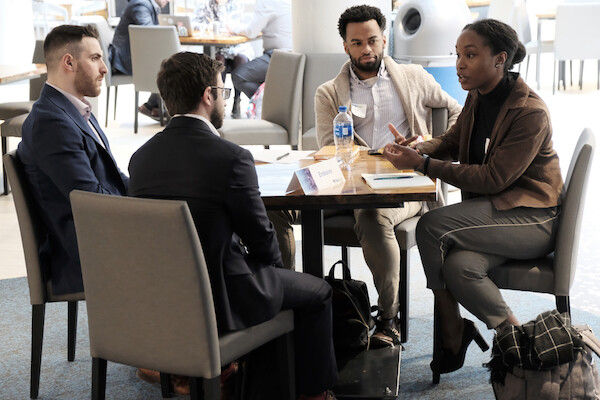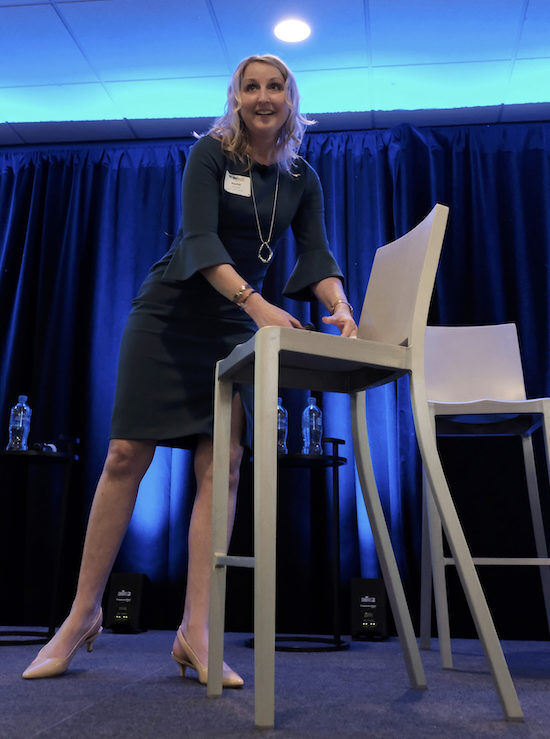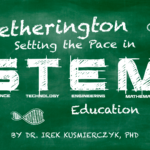Six months after undergoing an emergency heart transplant, Rachel Kuntzsch took the stage at the third annual MedHealth Summit to deliver the keynote address and a stirring message of hope and gratitude.
Rachel and her company – Public Sector Consultants – had been a key partner over the last three years helping to lead the MedHealth Steering Committee and the MedHealth Summit that was hatched out of TechTown Detroit and is now supported by over thirty cross-border partners.
Her unlikely story of courage and survival captured the imagination of the 300 health care practitioners, innovators, investors and entrepreneurs in attendance at Ford Field in downtown Detroit on April 18th and challenged them to consider their purpose in driving healthcare innovation.
“When you remember your why, your what becomes more impactful,” she told the crowd.
 In addition to inspiring keynotes, what sets the MedHealth Summit apart are the more than 250 one-on-one meetings organized between health-tech start-up companies and investors, health care providers and potential clients through the Market Ready Matchmaking and Investor Speed Dating platforms.
In addition to inspiring keynotes, what sets the MedHealth Summit apart are the more than 250 one-on-one meetings organized between health-tech start-up companies and investors, health care providers and potential clients through the Market Ready Matchmaking and Investor Speed Dating platforms.
“I had never been to such an event before,” said Dr. Brad Burke, product developer for the Windsor Gait Assist (WGA) medical device company. “I now understand better the steps needed to get my medical device to the market. I was also impressed by the quality of the innovations from other developers, and having the ability to pitch my idea to investors was quite useful.”
The day featured five outstanding panels.
One that yielded tremendous insights for healthcare startups was The Secret Sauce to Successful Pilots: Critical Lessons from Entrepreneurs and Healthcare Organizations moderated by Brad Martin of Fast Forward Medical Innovation.
The panel had three ‘first-in-class’ medhealth entrepreneurs that were refreshingly candid about their experiences – both setbacks and successes – while providing enterprising founders with sterling advice.
“Use the pilot to prove that you can execute a first limited roll-out,” says Greg Bowles, founder of FlexDex Surgical. “If it is unpaid, ask for value in terms of things like clinician feedback.”
Justin Adams was an electrical engineer at GM responsible for the check-oil light. He is now CEO of AlertWatch, which is a digital health company that created an anesthesia alert system that uses over 100 proprietary algorithms, automated calculations and alerts to give providers the ability to quickly assess clinical situations. It is a check-oil light for people, he says smiling.
“The goal in fact should be to not do a pilot,” he says, because even a pilot has to go through the same bevy of regulatory checks as a typical roll out, such as a server, security and ROI reviews.
 “Be careful of six year pilots,” Adams also cautions.
“Be careful of six year pilots,” Adams also cautions.
The Advanced Mobility: Expanding Patient Access to Care panel highlighted the innovation happening at the intersection of healthcare and mobility – a timely topic that will also be the theme of the upcoming fifth annual Hacking Health Windsor-Detroit in October.
Chief Bruce Krauter from Essex-Windsor EMS talked about the Vulnerable Patient Navigator (VPN) initiative which addressed the challenge of having 12,000 repeat callers who were calling 9-1-1 three times per year or more.
VPNs are attached to repeat callers and provide in-home visits, while also using virtual remote access to monitor things like blood pressure. In the first months the VPN program reduced usage by 40 per cent.
“It’s not just emergency transport anymore, we are going into the home,” said Susan Hawkins, Senior Vice-President of Population Health at Henry Ford Health Systems.
Tyler Jett, of autonomous shuttle company – Navya – talked about the opportunity to begin the provision of healthcare on the shuttle on its way to the hospital.
Shadi Mere, founder of mobility start-up Bedestrian, talked about the exciting pilot project his company has underway with a local hospital that involves their autonomous delivery robot delivering pharmaceuticals and medical equipment across the hospital’s campus.
He sees delivery bots on city sidewalks delivering prescriptions on the very near horizon.
Both Krauter and Hawkins emphasized the need for start-ups to establish a true partnership with health care providers.
“It’s important to view partnerships as a collaboration and not a sale,” says Hawkins. “I like working with companies that are not just coming with solutions, but with questions.”
Krauter echoes that sentiment, stating “companies need to understand the ground-floor before they get to the top floor.”
Another terrific panel was The Future of Platform Businesses in Healthcare, which included Pam Fleury of Oracle, Dr. Clifford Goldsmith of Microsoft, and Jordan Hayward of IBM talking about interoperability and openness being the new paradigm in cross-platform collaboration in healthcare.
Goldsmith noted that “tech adoption is fundamentally a process improvement issue.”
 Hayward observed that ultimately “patients will force change in the industry.”
Hayward observed that ultimately “patients will force change in the industry.”
The panel on Changing Governmental Influence on Healthcare Innovation was heavy on the maple syrup with Jocelyn Kohlmaier of Canada Health Infoway and Dr. Tom Mikkelsen of the Ontario Brain Institute joining Margaret McCammon of the Michigan Economic Development Corporation.
Naresh Singh – Chief Information Officer at St. Thomas Elgin General Hospital – made the drive from London, Ontario to attend the Medhealth Summit for the second year in-a-row.
“It’s just the right size where you can have meaningful conversations and collisions,” says Singh.
In between breaks – the morning’s keynote address by Rachel and her remarkable story was still fresh on everyone’s mind.
Shortly after leading an ordinary meeting of the Medhealth Steering Committee on November 9, 2018, Rachel attended her son’s musical recital where she felt unusually short-of-breath, especially for an avid athlete that spent a good part of her free time outdoors kayaking, cycling and running.
Within days Rachel was diagnosed with congestive heart failure brought on by a likely viral infection leading to an incredibly rare disorder called Giant Cell Myocarditis.
“I remember Dr. Nicklas holding my feet, delivering the bad news, it was the worst of the worst,” she says. “It’s funny what you remember,” referring to moments of compassion and human touch that she said made all the difference in the world to her and her family at the Frankel Cardiovascular Center at the University of Michigan.
 Within twenty-four hours she was on a transplant list and waiting for a donor match, which came on Thanksgiving Day – a miracle in itself.
Within twenty-four hours she was on a transplant list and waiting for a donor match, which came on Thanksgiving Day – a miracle in itself.
As she was being rolled into the operating room, she was asked to select a song.
A small but meaningful choice – one that was her very own.
The last thing she heard before going under was the first few lines of Fly Me to the Moon.
“Wouldn’t the last thing you want to hear to be Frank Sinatra?” she asked.
The surgery was a success, but recovery was slow and painful. Small victories were celebrated, like lifting her head up from her pillow in the recovery room, taking a few extra steps from her bed, reducing by one the more than 200 pills she was taking each week.
Her goal was to be home for Christmas, and on December 8th she got her wish and was released from hospital.
Not too long after she attended her son’s holiday concert in the same auditorium where her journey began.
April was National Organ Donor Month, and Rachel didn’t miss the opportunity to tell the audience that one donor can save the life of 75 people.
“My donor left a legacy of life and love,” she said.
For the second year in a row – the Medhealth Summit was home to a long, rousing standing ovation.

Dr. Irek Kusmierczyk, PhD is the Director of Partnerships at WEtech Alliance and member of the Medhealth Steering Committee. Medhealth is a cross-border collaboration hatched at TechTown Detroit and powered by over thirty cross-border partners that is connecting, convening, and educating the medical innovation ecosystem in Southeast Michigan and Southwest Ontario to accelerate the adoption of technologies that improve quality of care and contribute to economic growth.






